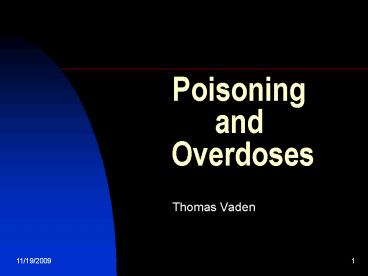Poisoning and Overdoses - PowerPoint PPT Presentation
1 / 31
Title:
Poisoning and Overdoses
Description:
Discuss the emergency medical care for the patient with a possible overdose. ... need for medical direction in caring for the patient with poisoning or overdose ... – PowerPoint PPT presentation
Number of Views:496
Avg rating:3.0/5.0
Title: Poisoning and Overdoses
1
Poisoning and Overdoses
- Thomas Vaden
2
Objectives
- Recognize the signs/symptoms associated with
poisoning. - Discuss the emergency medical care for the
patient with a possible overdose. - Discuss the 6 ways that poisons enter the body,
and recognize examples.
3
Objectives
- Explain the rational for administering activated
charcoal - Categorize alcohol as a drug and describe its
effects on the body in combination with
hypothermia - Recognize the need for medical direction in
caring for the patient with poisoning or overdose
4
Poison Control Center
- What is the number for the poison control center
in Alaska - 1-800-478-3193
5
Poisoning
- The adverse effects of plants, foods, chemicals
or pharmaceutical agents on the body
6
Overdose
- Poisoning by excessive dose
7
Two Peak Age Groups
- The first group is toddler to preschool age
when children are exploring there environment - The second group is young adult age group, when
ingestion is a form or suicidal behavior
8
Hypothermia and Alcohol
- Ingested.
- Alcohol is a vasodilator.
- Body temp is lowered.
- At around 94 degrees shivering stops .
- Blood is shunted to core organs.
9
Hypothermia and Alcohol (cont.)
- Person is hypothermic continues to consume
alcohol. - Alcohol sits in stomach is not absorbed.
- Person goes inside.
- Body has external heat source.
- Alcohol dump.
10
Routes of Absorption
- Ingestion
- Absorption
- Dermal exposure
- Ocular exposure
- Injection
- Inhalation
11
Scene Survey and Assessment
- Scene survey
- Is the world safe for you to be there?
- Scene information
- Unusual odors,
- Specific medication
- Specific chemicals
12
Scene information
- Do not transport materials that may be a risk.
- Vomit.
- Stool samples.
- Digital Cameras may be of assistance.
13
General Assessment
- Management of poisoning is primarily supportive
- Basic Life Support (BLS)
- Level Of Consciousness (LOC)
14
What do we do
- Initial Assessment
- General impression of Patient
- Determines Level of Consciousness (AVPU)
- Airway
- Breathing
- Circulation
- Pulse
- Hemorrhage
15
Assess Skin
- Skin color
- Skin temperature
- Skin Condition
- Redness
- Blisters
16
- Identifies priority Patients and makes transport
decision. - Selects and performs appropriate assessment
17
Focused History and Physical Exam
- Assess illness and condition based on chief
complaint (c/c) - Inspects and palpates areas based on chief
complaint (c/c)
18
Specific Medical Questions
- Poisoning Overdose
- Substance
- When exposed/ingested
- Amount
19
Specific Medical Questions
- Poisoning Overdose
- Time Period
- Interventions
- Estimated weight
20
Obtains SAMPLE History
- S Signs and symptoms
- A Allergies
- M Medication
- P Pertinent medical history
- L Last oral intake
- E Events
21
Obtains baseline vitals
- Blood Pressure
- Pulse
- Respirations
22
Transport
- Properly packages and transports as needed.
23
Rapid Assessment
- Performs a rapid assessment if indicated by
findings
24
Continuing exam
- Moves to detailed exam, ongoing exam as
indicated. - Usually performed while transporting.
25
Ongoing Assessment
- Repeats initial assessment
- LOC
- Airway
- Breathing
- Circulation
26
Ongoing Assessment
- Reassess Vital signs
- Blood pressure,
- Pulse
- Respirations
27
Ongoing Assessment
- Reassess all interventions
28
Management
- Inhalation
- Absorption
- Injection
- Ingestion
29
Management
- Reports
- Medical Direction
- Poison Control Center
- Emergency Department
30
Summary
- Recognize the signs/symptoms associated with
poisoning. - Discuss the emergency medical care for the
patient with a possible overdose. - Discuss the 6 ways that poisons enter the body,
and recognize examples.
31
Summary
- Explain the rational for administering activated
charcoal - Categorize alcohol as a drug and describe its
effects on the body in combination with
hypothermia - Recognize the need for medical direction in
caring for caring for the patient with poisoning
or overdose































